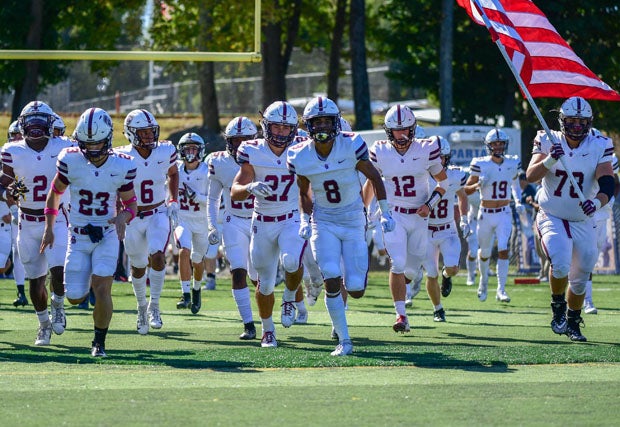On the heels of Wednesday's decision by the Ivy League to cancel its fall 2020 sports season due to COVID-19, talk of high school football flipping its season to the spring is getting louder. It got louder still Thursday when New Mexico became the first state to officially push football and soccer back to the spring season.
See story.
Each state abides by different rules set by its own governing body and many of those states could split in decisions when or if the 2020 fall season will occur.
Here are 10 top challenges for moving high school football from the fall of 2020 to the spring of 2021.
1. LogisticsSpring is already the busiest of three seasons in the prep sporting world, and adding football into the final semester is a logistic problem few athletic directors or maintenance workers want to tackle. Finding field time to practice, let alone schedule games, will be more than problematic. Now faced with that reality, New Mexico officials are talking flexibility, patience and likely shorter season, such as a 6- or 7-game football regular season. "We sit back to hurry up and wait," Espanola Valley athletic director Ira Harge Jr. told the
Santa Fe New Mexican. 2. Field conditionsCoordinating practice time between multi-level teams in football, soccer, lacrosse, and track and field is challenging enough. Keeping those fields playable — even ones with artificial turf — adds another vital concern over safety.
3. Pick a sportA growing number of professional athletes have encouraged high school players — even elite ones — to spread their wings and play multiple sports. Football moving to the spring would largely eliminate that push, especially the common football-baseball or football-track two-sport athlete. In many cases, picking between football and baseball will be extremely difficult. "There's too many crossover sports, and I feel like once you get into switching things, getting back out of it becomes a big issue,"
Shawnee (Springfield, Ohio) athletic director Steve Tincher told the
Dayton Daily News. "I wouldn't be really enthused about playing football in the spring and then turn around playing football in the fall again."
4. Another choice: high school or college?We reported here last week that many top football recruits would choose graduating high school early and attending spring football practice with their chosen college than play for their high school team. It will be a very difficult decision for many of the top high school players in the country. "Man, that's a tough one," said
St. John Bosco (Bellflower, Calif.) receiver Beau Collins, a Clemson commit. "I would have to sit down and talk with my parents about making that possibility."
5. Recruiting exposure The National Signing Day period for Class of 2021 football players is December (early) and February (regular) yet the spring football season would take place after those dates. For those who sign to colleges, risk of injury might be too great and motivation to play the high school season could teeter.
6. Spring Night Lights? Hard to imagine a Friday night football game in the middle of April eliciting the electricity — or fans — of a game in October and into Novemeber. Then again, there likely will be less chance for fans in the stands during the fall than the spring.
7. Weather permittingSwitching the seasons will flip the weather challenges drastically in most of the country, especially the Deep South and Northeast. Summer practice and games always present excessive heat precautions and by the end of the season, rain, chill and snow are often obstacles. Starting practice in the winter, finished off with championship games in late spring will offer the same challenges, but in the opposite order. "I think spring football is the last option we should look at," Minnesota Football Coaches Association assistant executive director Dave Nelson told the
Star-Tribune. "But at least it's an option."
8. Jumping state lines The uncertainty of fall sports in Illinois were each partial factors in the recent out-of-state transfers of a pair of top recruits from Nazareth Academy (La Grange Park, Ill.) as 5-star quarterback J.J. McCarthy went to the nation's No. 1 team IMG Academy (Bradenton, Fla.) and tight end Landon Morris to Fishers (Ind.). Each noted those concerns during their transfer announcements, even though each have secured college scholarships: McCarthy to Michigan and Morris to Syracuse. High school coaches in Michigan
voiced concerns that a state-jumping transfer trend could continue in their state after Gov. Gretchen Whitmer asked the Michigan High School Athletic Association to consider moving football to the spring last week.
With players either choosing not to play spring football due to college commitments, playing other sports or concerned over too much wear with back-to-back spring and fall seasons, roster sizes could shrink substantially. That doesn't bode well for a sport already under siege over concussions and injury concerns.
10. Referee shortageThe shortage of high school referees — described in 2017 by the NFHS as an "exodus of officials at an alarming rate" — continues to worry as reported by multiple outlets including
Globalsportmatters.com. Many states have reported a 10-20 percent decrease in officials over the last decade. With so many sports competing at one time in the spring, qualified referees will be at a premium.

Will teams such as New Jersey power Don Bosco Prep take the field in the fall of 2020 or have to wait until the spring of 2021?
Photo by Pete Hagedoorn
